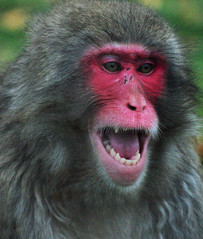The Red Faced Monkey
By Analicia Sanchez
The Red Faced Monkey
Human Interaction
- Scientist Center for Animal Welfare
- Animal Scientist
- Zoologist



Species Information
- The scientific name for The Red Faced Monkey is (Ateles Paniscus)
- There are estimated to be 35,000 to 50,000 while numbers are declining
- Red Faced Monkeys give life birth
- They can only have one child at a time
- Baby Red Faced Monkeys tend to hang on there mothers back and legs

species info continued
- Red Faced monkeys give live birth
- They can only have 1 child at a time
- Baby Red Faced Monkeys cling to there mothers body
- They are old enough to live alone at age 1
- The mothers are pregnant 7.5 months before giving birth


species info continued
- They are mature enough to have there own children at 4 to 5 years
- They gather food in groups no more than three
- Red Faced Monkeys usually live to about 20 to 33 years
- They rest twice a day 8 to 10 and then 12 to 12:30


species info continued
- Red Faced Monkeys communicate in many ways that include smelling licking screaming grunting whistling and smelling
- Red Faced Monkeys bark when scared
- The Red Faced Monkeys are the largest monkeys in the world
- They are found in Brazil, French Guiana, Guyanna, and Suriname

Predators and Prey
- The Red Faced Monkey is an omnivore
- They eat insects leaves bark grubs flowers berries and fruit
- The predators of a Red Faced Monkey include jaguars, pumas, and humans are the worst predator



Interesting Facts
- Red Faced Monkeys play an important role in the ecosystem by dispersing seeds
- There faces are red to prevent interbreeding
- Males have light faces while females have dark faces

Interesting Facts
- Because of there ability to jump and climb they are known to live in the top layers of the rainforest
- The oldest Red Faced Monkey to live was 46 years old
- They are sometimes found in zoos
- They live in groups of 20 to 23 at a time


References
- Wikipedia
- World Wildlife
- National Geographic Society
- Fact Zoo
Thanks for listening and watching
